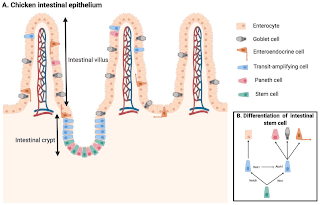An In-Depth Look at Chicken Cells: Structure, Types, and Functions
Chicken cells, like those of other multicellular organisms, are the fundamental building blocks of life. These cells come in various types, each specialized to perform unique functions that are crucial for the survival, growth, and reproduction of chickens. Understanding the structure and function of chicken cells provides valuable insights into avian biology and can inform better poultry management practices.
1. Basic Structure of Chicken Cells
The basic structure of chicken cells is similar to that of other eukaryotic cells, characterized by several key components:
- Cell Membrane: This phospholipid bilayer surrounds the cell, providing structure and regulating the movement of substances in and out of the cell.
- Cytoplasm: The gel-like substance inside the cell membrane, containing organelles and cytoskeletal elements.
- Nucleus: The control center of the cell, housing DNA and coordinating cellular activities such as growth, metabolism, and reproduction.
- Organelles: Specialized structures within the cell, including mitochondria (energy production), endoplasmic reticulum (protein and lipid synthesis), Golgi apparatus (protein modification and sorting), and lysosomes (waste degradation).
2. Types of Chicken Cells
Chicken cells can be broadly categorized into several types based on their function and location within the body.
Muscle Cells (Myocytes): These cells are responsible for movement and include skeletal, cardiac, and smooth muscle cells. Skeletal muscle cells are striated and voluntary, cardiac muscle cells are striated and involuntary, and smooth muscle cells are non-striated and involuntary.
Nerve Cells (Neurons): Neurons are specialized for transmitting nerve impulses. They consist of a cell body, dendrites (receiving signals), and an axon (sending signals). Neurons are essential for coordinating sensory and motor functions.
Blood Cells: There are several types of blood cells, including red blood cells (erythrocytes), white blood cells (leukocytes), and platelets (thrombocytes). Erythrocytes transport oxygen, leukocytes are involved in immune defense, and platelets play a role in blood clotting.
Epithelial Cells: These cells form protective layers covering the body surfaces and lining internal organs and cavities. They are involved in protection, secretion, and absorption.
Reproductive Cells: These include sperm cells in males and egg cells (ova) in females, which are involved in reproduction.
3. Functions of Chicken Cells
Each type of chicken cell has specialized functions that contribute to the overall functioning of the organism.
Metabolism and Energy Production: Cells, particularly muscle cells, are involved in metabolic processes that produce energy necessary for movement, growth, and other activities. Mitochondria within these cells play a critical role in energy production through cellular respiration.
Immune Defense: White blood cells are crucial for protecting chickens against infections. They identify, target, and eliminate pathogens, playing a key role in the immune response.
Transport of Oxygen and Nutrients: Red blood cells transport oxygen from the lungs to tissues and carry carbon dioxide back to the lungs for exhalation. Blood cells also transport nutrients absorbed from the digestive tract to various parts of the body.
Sensory and Motor Functions: Neurons transmit signals that coordinate sensory inputs (like sight and sound) and motor outputs (like movement). This coordination is essential for responding to environmental stimuli and performing complex behaviors.
Growth and Repair: Various cell types are involved in growth and repair processes. For example, fibroblasts produce extracellular matrix components that help in wound healing and tissue repair.
Reproduction: Reproductive cells are involved in the production of offspring. Sperm and egg cells undergo fertilization to form a zygote, which then develops into a new organism.
Implications for Poultry Management
Understanding chicken cells and their functions is crucial for effective poultry management. Here are some implications:
Nutrition: Providing a balanced diet that supplies all necessary nutrients supports cellular functions, including growth, energy production, and immune defense.
Health Monitoring: Regular health checks can help detect abnormalities in cell function, such as infections or metabolic disorders, allowing for timely intervention.
Breeding Programs: Knowledge of reproductive cells can inform selective breeding programs aimed at enhancing desirable traits such as growth rate, egg production, and disease resistance.
Disease Prevention: Understanding the immune cells' function helps in developing effective vaccination and disease prevention strategies, ensuring the flock remains healthy.
Conclusion
Chicken cells are fundamental to the bird's overall physiology, with each cell type performing specialized functions essential for life. From muscle cells that enable movement to immune cells that protect against diseases, understanding the diverse roles and functions of these cells can enhance poultry management practices. By ensuring optimal nutrition, monitoring health, and implementing effective breeding and disease prevention strategies, poultry farmers can promote the well-being and productivity of their flocks.
#poultry #chicken #breeder #broiler #farming #layer #poultrytechnology poultrytechnology.blogspot.com #meat #feed #chick #DOC #veterinarian #poultrytechnology #animal #husbandry #latest #research #feedadditives #vaccination #diseases #poultrydiseases #diagnosis #cell #neuron #erythrocyte






Post a Comment